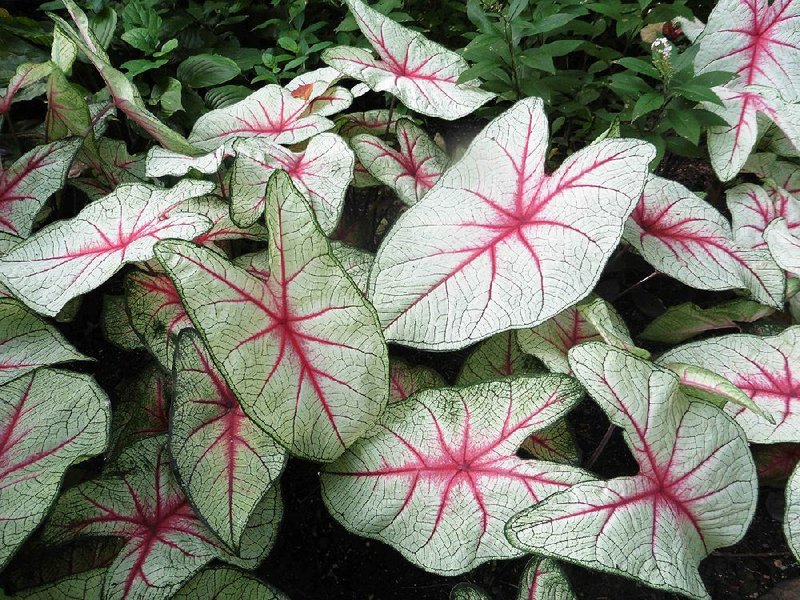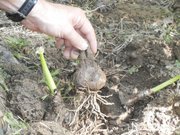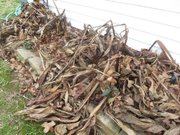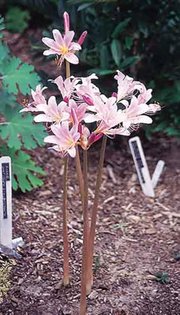When you say "bulbs," most people think of spring-bloomers such as daffodils and tulips, but a whole range of summer bulbs grace our gardens.
Some are winter-hardy and grown as perennials, while others are tender and must be lifted and stored for the winter.
Summer bulbs found in many Arkansas gardens include elephant ears, caladiums, dahlias, gladiolus, canna and pineapple lilies, lycoris (surprise lilies) and amaryllis.
ELEPHANT EARS
Common elephant ears are winter-hardy statewide, but some of the more decorative varieties with variegated or dark foliage are only moderately hardy. To protect your investment and to ensure you have these bulbs every year, you should lift and store them, either before a frost or immediately after one.
Caladiums are closely related but are never winter-hardy. Caladiums thrive in warm soils, so don't be too quick to replant next spring. If the soil is cool at planting time, they are often slow to establish.
Both of these plants thrived during this mild, moist summer and gardeners have some of the largest plants we have seen.
DAHLIAS
Dahlias come in many sizes with many shapes of blooms. Occasionally they will overwinter, in a mild winter.
Since they are native to Mexico and Central America, they like a fairly mild winter.
To guarantee they will come back, it is best to dig the bulbous
tubers in the fall. Dahlias grow from a fibrous root system of fleshy stems radiating from a central stalk.
TOUGH GUYS
Lycoris (surprise lilies), canna lilies and pineapple lilies (Eucomis) are considered winter-hardy in Arkansas and can be left in the ground from year to year.
If you have cannas that need division, they can be divided as they emerge in spring, or you can lift the bulbs this fall and store for winter, then divide and replant in spring.
Other lilies that are too crowded can also be dug, divided and then immediately replanted in fall.
STORING BULBS
Digging and storing tender bulbs requires some work, and you will need to consider your storage space.
I usually treat some of these tender summer bulbs as summer annuals, planting new ones each year. I always buy new caladium bulbs, and if an amaryllis comes back on its own, that is a bonus.
But this is your decision. You can save them all or only save bulbs that are expensive or hard to find.
How cold winter is determines the survival rates, and there is no way of predicting that. So if you want to guarantee their return, to be on the safe side, you need to lift and store the more tender bulbs.
If you want to take your chances, leave them in the ground. Wait for a killing frost and then pile on an extra layer of mulch, but not too quickly. You want the plants to be dormant before you cover them. If you add extra cover while they are still actively growing, the bulbs will not have a chance to go dormant. They might rot.
To store bulbs, you have several options.
You can begin to dig them as the leaves begin to decline in the garden, but if they are still showy and growing well, wait until frost is in the forecast or immediately after a frost.
Cut off the spent foliage and dig up the bulbs. Use caution that you don't injure them as you dig.
Don't divide the cluster of bulbs as they go into storage. Next spring you can divide them before you replant.
Before storing the bulbs, you want to air dry or cure them. Lay them in a single layer on top of newspapers in a cool, shady dry place for several days -- up to a week.
Shake off as much dried soil as possible and store the dried bulbs in a breathable container. They cannot be stored loose as the spring-blooming bulbs (such as crocuses, tulips and daffodils). Summer bulbs must be stored in a material that protects them from totally drying out, which can injure or even kill the bulb.
A cardboard box with a layer of dry peat moss, vermiculite, shipping peanuts or shredded paper works well.
Don't store bulbs in a nonbreathable plastic container, and don't crowd them or they can rot during storage.
Once you have them in the container, store in a cool place that will not freeze. Replant in spring after all chances of frost have passed.
AN EXCEPTION
Various gladioli are available in Arkansas, and some are hardier than others.
As with caladiums, some gardeners treat their gladioli as annuals and plant new corms each spring. But they, too, can be lifted and stored for winter.
But they are treated a little differently from other summer bulbs. Gladiolus corms can be stored in the open, without the protection of peat moss or other filler. The corms can be dug any time after the foliage has died back. Let them air dry for two to three weeks, then store them loose in a paper or a mesh bag.
AMARYLLIS
Many gardeners stock up on amaryllis bulbs before Christmas.
The showy, large bulbs are not supposed to survive our winters outdoors, but we have been having more and more success these days. Many Arkansas gardeners wait until a killing frost, add an extra layer of mulch and then wait until spring to check on survival.
Others lift the bulbs as fall is ending and cut off the foliage. They take them indoors, pot them and store in a cool, dry place. Then they wait for new growth. Once bulbs begin to sprout, begin watering and move the pots into a sunny spot. Typically, they will bloom within six to eight weeks indoors.
Most of our summer bulbs are still growing strong, but others have begun their decline. Knowing how to handle, store and/or divide them will allow you to make the most of the plants you grow.
Janet B. Carson is a horticulture specialist for the University of Arkansas Cooperative Extension Service.
HomeStyle on 09/24/2016



